

Letter from theeditors:
Dear reader,

Welcom e to the newest edition of Veritas: STEM & Com m unity
We are so pleased that you are interested in what this edition of our m agazine has to offer. From bringing back extinct rhinos to discussing analog com putation, this edition of Veritas seeks to do justice to the m yriad of ways in which we see STEM in the world around us.
As new editors, we?ve decided to break from tradition and add a few special elem ents to this m agazine. From the beginning of the 2022-2023 school year, we have incorporated STEM features from in and around the Westm inster com m unity W hile keeping our typical articles on science and technology, we hope that by adding in features from m em bers of our robotics team , innovation fellows, and others involved in STEM activities at Westm inster, Veritas will foster an even greater sense of inclusion for m em bers of our com m unity
W ith the world we live in today, the im portance of journalism and the necessity of bringing factual evidence to the general public has severely increased over the past few decades. Science, technology, engineering, and m athem atics are integral parts of any functioning society in the 21st century ? expanding access to inform ation on these topics is at the core of what Veritas and m any other scientific publications stand for.
We believe Veritas represents the crossroads between the hum anities and STEM ; we hope to bring a hum an touch to the classic topics while rem aining true to the factual, precise journalism that m akes us a science m agazine
W ithout further ado, welcom e to Veritas Volum e 6 We?ve all worked especially hard on this m agazine, and would like to thank our faculty advisors, M r. Abraham and Dr. Pace, for their guidance this school year. Thank you to each and every staff reporter, editor, and layout m anager who helped bring this edition to fruition. We couldn? t have done it without you.
Thanks for reading, Alex and Nandana
TEAM VERITAS
H EA D ED I T O RS:
Alexandra Kent
Nandana Avasarala
ST A FF W RI T ERS:

Daniel Qiu
Sam anyu Ganesh
John Overend
Avi Agrawal
Caroline Chu
Lars Wust
M ax Scholle
George Jabren
ST A FF A RT I ST S:
Kirsten Liang
FACU LT Y A D V I SO RS:
Dr. Julie Pace
M r. David Abraham


23
A New Hope: How the San Diego Zoo Aim s to Bring Back an Extinct Rhino Subspecies
CarolineChu
Creating the Tottori Table
LarsWust

33
29
FDM ax: Original 3D Printer Design
Max Scholle
Spotlight on the Innovation Fellows
Nandana Avasarala
38
Com p u ter Per son GeorgeJabren
Server room tedium thrum s Loft piling dust-caked m achine M y finger?s carved clearing in Specks of tim e resound, m uted

Pilfered dusty m ines laugh They wheeze Our fetid fum es--ghastly hum ors-Speckling m uffled peoples through tim e Roars, blast, past the plastic blades.
Fum es, hum m ing, fuel hourly feats: Hence, dim m ing prospects whisk breath off Bit by raging bit past fading screen. Can? t leave them left to their devices
Prospectors breed whiz codes
Hence, nascent cries from the cham ber?s circuit
Bear the device?s clan absent, lifeless There rem ains one: toned, steeled, and trained.
Natal crucible fuels corporate crim e; To hold the fittest m ind, I despise m y stolen brain. Of rem ains, I?ve none To honor the nonliving dead
To hold this survivor, I deplore Thrum m ing server room terror
I?m sorry, you nonliving dead, These fingers crave creation.
Linda pastan pantoum
Nathalie diaze
M aria hum m el ?Station?


A n alog Com p u tati on an d M oor e?s L aw : T h e
Fu tu r e of D eep L ear n i n g an d th e
En vi r on m en t Samanyu Ganesh
As the size of the everyday com puter chip continues to leapfrog the predictions of M oore?s Law, so too does the am bition of data scientists m ultiply in m agnitude. Although significant advancem ents are being m ade every day, with ram ifications in all fields of society, the inefficiency of classical com puting techniques has im posed increased stress and strain on the environm ent, exacerbating the effects of clim ate change. As a result, som e experts believe that now is the optim al tim e to turn a new leaf? enter analog com puting
The very first com puters, built at the dawn of the 20th century, were analog, m eaning that they used the continuous variation of natural and physical phenom ena to perform calculations? rotating shafts and gears offered novel usage and applicability in approxim ating solutions to num erical equations. Such innovations were em ployed in the course-predicting m echanism s of torpedo system s in subm arines, forecasting spring flood patterns in the M ississippi basin, as well as in state-of-the-art bom bsight technology in aircrafts during W W I. Yet when the Second World War rolled around, a com putational revolution m aterialized, centered around the digital transistor; com puters with the capacity for program storage and m em ory soon eclipsed their analog predecessors. The likes of H arvard m athem atician Howard Aiken and British cryptanalyst Alan Turing ascended to the forefront of the m ovem ent, building upon the groundwork of Hungarian-Am erican polym ath John von Neum ann. As Tim Vehling, senior vice president of product and business developm ent at M ythic, one of m any recent startups in the field, sum m arized to DigitalTrends, ?[Digital com puting] was cheaper, faster, m ore powerful, and so forth.?

Based in Redwood City, California, the heart of Silicon Valley, with facilities in Austin, Texas, M ythic seeks to hasten an age of low-power, low-cost, yet high-perform ance analog com puting architectures? their newly-announced M 1076 chip, packed with tunable resistors, functions off of real-world input voltages, collecting the current outputs as storable values To an untrained eye, this process appears highly abstract, but it is rooted entirely in an equation fam iliar to all young physicists who have explored circuitry: Ohm ?s law, which states that voltage equals the product of resistance and current. As such, M ythic Analog M atrix Processors (AM Ps) have the newfound capability to conduct large-scale operations of m atrix m ultiplication at sm aller tim e and space (m em ory) com plexities, an infrequent result in the world of optim ization
Generally speaking, there exists a stringent tradeoff between m em ory capacity and algorithm efficiency of com putational infrastructure, yet analog techniques m anage to greatly im prove both; analog-based chips elim inate the need for m em ory m ovem ent and reallocation, sim ply utilizing resistors as strongholds of inform ation, whilst sim ultaneously allowing for hundreds of thousands of such calculations occurring in parallel Neural networks, the deep-learning m ega-algorithm s m odeled after the firing of neurons in the hum an brain, are fueled by vector operations with m atrices at every step of the way? thus, as researchers push these networks to the lim it, their groundbreaking experim ents need not rely anym ore on the frustratingly slow calculation speeds of classical chips, which not only com m only yield m em ory allocation errors, but sequentially perform m ultiplication operations, one by one
Furtherm ore, the efficacy of these program m able arrays of resistors (which replace the transistors found in digital chips) are projected to surpass the physical lim itations of M oore?s law Pioneering developm ents have drawn into question the validity of the statem ent itself: Does the quantity of transistors squeezed onto an integrated circuit truly double every 18 m onths, or was M oore?s prognosis sim ply a wish stated as truth, with hopes of sustaining exponential progress for decades to com e

W hatever the reality, the barrier of plausibility for classical chips is fast approaching? analog technology paves the way forward Kerem Gülen of Dataconom y highlights a recent M IT interdisciplinary study that aim s to bolster energy efficiency of the resistors in analog circuits. At the M IT.nano facility, robust nanofabrication techniques have augm ented the analog architectures with the inclusion of an inorganic m aterial com patible with silicon production m ethods. The researchers??protonic?program m able resistors m odulate electric conductivity by m eans of the electrochem ical insertion of protons into insulating oxides? the newly-added com ponent accelerates the ionic device, am plifying the strength of the m agnetic field.


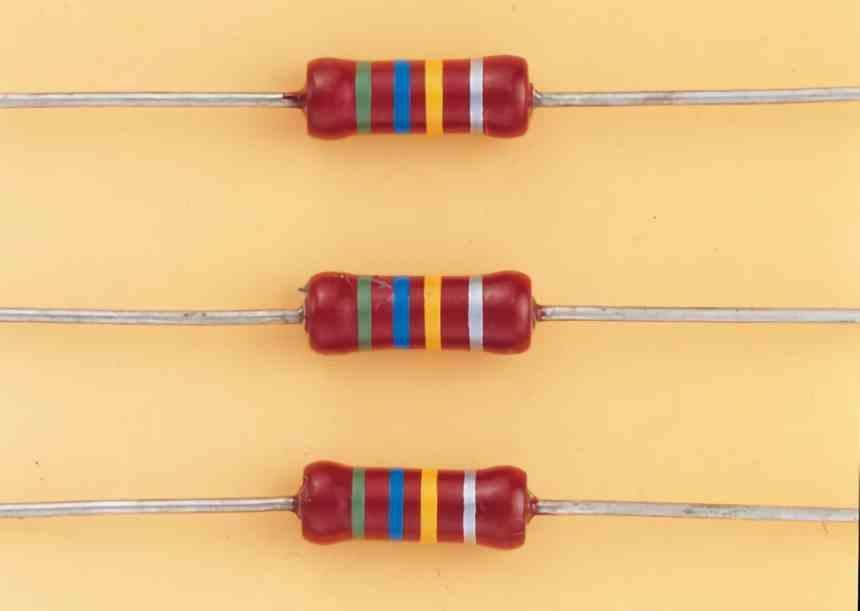
The electrom agnetism of program m able resistors, while highly popular am ongst proponents of analog com putation, are not the only prom ising m ethod of harnessing com puting power with analog devices. Cem Dilm egani, a user of the research-sharing platform AIM ultiple, underscores quantum annealing, an adiabatic physical process related to quantum tunneling and entanglem ent, which can be channeled into solving optim ization problem s for today?s neural networks. By m anipulating the truly random (as opposed to the pseudo-random generation of classical com puters) nature of subatom ic particles, scientists have now exercised the capability to m aintain the stability of qubits (the quantum analogues of classical com puter bits) for longer periods, effectively eradicating m ost of the insignificant quantum noise garnered with other approaches
According to Statista, last year, Intel was responsible for 3 27 m illion m etric tons of carbon dioxide em issions; perhaps it?s opportune for the big-data tycoons of Silicon Valley to acknowledge the above research and join the analog crusade, with the horsepower necessary to propel society into a golden age of coexistence between com puters and the environm ent.
Bibliography
Dilm egani, Cem . "Quantum Annealing in 2022: Practical Quantum Com puting."
AIM ultiple, 14 June 2022, research.aim ultiple.com /quantum -annealing/. Accessed 23 Oct 2022
Dorm ehl, Luke "Analog A I ?It sounds crazy, but it m ight be the future" DigitalTrends, Digital Trends M edia Group, 10 Apr. 2022, www.digitaltrends.com /com puting/m ythic-ai-analog-artificial-intelligence/.
Accessed 23 Oct 2022
Gülen, Kerem . "Analog Deep Learning Paves the Way for Energy Efficient and Faster Com puting " Dataconom y, Dataconom y M edia Gm bH , 1Aug 2022, dataconom y.com /2022/08/analog-deep-learning-ai-com puting/. Accessed 23 Oct. 2022.
Intel. "Intel's Greenhouse Gas Em issions Worldwide from 2015 to 2021(in M illion M etric Tons of Co2 Equivalent)" Statista, Statista Inc , 11M ay 2022, https://www-statista-com .westm inster.idm .oclc.org/statistics/1200873/
intel-greenhouse-gas-em issions-worldwide/
H ave you ever looked outside and wondered how hum ans are able to harness so m uch energy despite the steady decline of the available non-renewable resources?For exam ple, fewer and fewer factories producing black sm oke are present today and m ore wind turbines and solar panels are beginning to take over that space That is because scientists have found new ways to obtain power in a m uch m ore efficient and environm entally friendly way. Research has determ ined the am ount of carbon dioxide and harm ful gas em issions are projected to reach an unhealthy rate at a rather quick rate and fortunately for hum ans, they have found som e solutions that com bat this global issue. Som e state of the current econom ic applications includes, but are not lim ited to, the generation of electricity and transportation
One inconvenience with the constant usage of oil, coal, and other non-renewable resources is that they will eventually run out, therefore, it is crucial to capitalize on renewable resources. According to Octopus Energy, scholars believe that ?If we keep burning fossil fuels at our current rate, it is generally estim ated that all our fossil fuels will be depleted by 2060. New reserves will probably be found before this point, extending the deadline som ewhat, but it is worth rem em bering that if we are to lim it global warm ing to the 'relatively' safe level of 2C by 2050, 80%of coal, 50%of gas and 30%of oil reserves are "unburnable".?The year 2060 surely is right around the corner and hum ans are advancing at an im m easurable rate As a result, governm ents and independent agencies around the world are fast to im plem ent tools that help reduce the usage of these valuable resources. Exam ples include: wind turbines, solar panels, and dam s and they all work together to gather energy and replicate the sam e product as fossil fuels. These renewable resources are unlim ited, good for the environm ent, and reliable (for the m ost part) com pared to fossil fuels, however, one question arises: ?W hy are hum ans still using nonrenewable resources??The problem is efficiency. Statistics by Consum erAffairs show that natural resources have around fifteen to twenty percent efficiency com pared to fossil fuels having forty to sixty percent efficiency (The energy lost is usually turned into therm al energy) .
Additionally, in unprecedented circum stances such as cloudy days and windless days, etc where there will not be sunlight to power solar panels or wind to m otor the panels. Despite the benefits renewable resources have, the efficiency of these fossil fuels seem s to outweigh the harm s. Therefore, scientists are currently finding ways to obtain a constant source of efficient green energy source: nuclear energy. Nuclear energy em its the lowest am ount of carbon em issions and is responsive to both clim ate change and greenhouse gas em issions, but it is extrem ely dangerous and expensive to build No need to worry at this point in tim e as scientists are hard at work seeking to find alternatives to slowly dim inish the harm s of green energy and soon, our lives will change for the better with a consistent source of energy generation



"Governments and independent agencies around the world are fast to implement toolsthat help reduce theusageof these valuable resources."
In recent history, com panies such as Tesla and Nissan have stepped forward in transform ing from gasoline-powered vehicles into electric ones in efforts to lower the carbon footprints left behind by them . In April 2016, the United States signed the Paris Agreem ent in which they hope to achieve clean, affordable energy by 2030 and net-zero em issions by the year 2050. So far, a total of one hundred and ninety-two countries and the European Union have joined in on the efforts in the Paris Agreem ent. One big change is the recent shift to electric cars. M any benefits include saving m oney on gas, quicker acceleration (for the sports car enthusiasts), and m ost im portantly, the low am ount of em issions these cars have. On average, electric cars em it around thirty-four percent of the em issions com pared to gas cars. This is already an enorm ous step forward in reaching the goals of the Paris Agreem ent. Besides em issions, experim ents done by the City of M oreno Valley present that ?rivers save about $700 in fuel costs per year while driving electric cars.?Although seven hundred dollars does not seem like a lot, the long-term benefits to one?s wallet and the Earth are alm ost priceless. As a result, m any other car com panies such as Toyota, BM W, and Volvo have jum ped in on this industry in hopes of m aking the world a safer place





All in all, green energy is the direction of our future. Despite the m inor inconveniences it brings, one can be sure that in the future, all of these will be resolved. Global warm ing has been a hot topic in recent years because of the rise of the sea level, anim als dying, and harm ful chem icals floating around in the air. Our lives are in danger as of right now, but these new techniques of energy generation and transportation help slow down these trends and it acts as a great leap forward into a m ore efficient and healthy alternative to fossil fuels.
Works Cited
Kaltenekker, Bill, and Kathryn Parkm an ?Solar Energy vs Fossil Fuels? Consum erAffairs, Consum erAffairs, 12 M ay 2022, https://www.consum eraffairs.com /solar-energy/solar-vs-fossil-fuels.htm l.
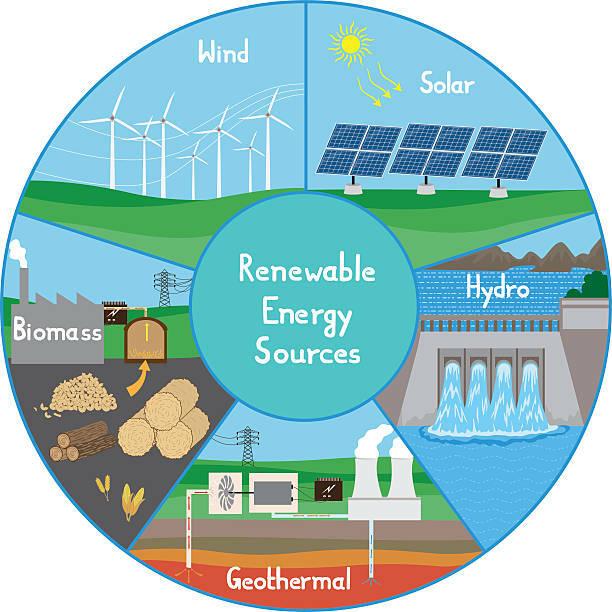
?Nuclear Power.?W ikipedia, W ikim edia Foundation, 14 Oct. 2022, https://en wikipedia org/wiki/Nuclear power?scrlybrkr=d30e9845
Rangaiah, M allika. ?Can Electric Vehicles Save the Overall Environm ent??Analytics Steps, https://www analyticssteps com /blogs/can-electricvehicles-save-overall-environm ent
?W hen W ill Fossil Fuels Run out??Octopus Energy, https://octopus energy/blog/when-will-fossil-fuels-run-out/
#:~:text=If%20we%20keep%20burning%20fossil,will% 20be%20depleted%20by%202060
Red u ce M osqu i to-Bor n e I lln ess
John OverendIt?s happened to all of us: you?re sitting outside on a sum m er night when you feel an itch from a m osquito bite. W hile m osquitoes are a sum m er annoyance to m any, they are also the deadliest anim al on the planet in term s of deaths. M osquitoes kill about 725,000 people through disease every year and infect m illions m ore (Pfizer). Specifically, the species Aedes (Ae.) aegypti, known conventionally as the yellow fever m osquito, is the prim ary spreader of the Zika virus, as well as spreading West Nile virus, chikungunya, dengue, and m ore potentially deadly diseases (Weissm an). Luckily, scientists around the world are m odern biotechnology to elim inate disease-carrying m osquitoes around the world, including Ae. aegypti.
Current practices for m osquito rem oval (pesticides, etc?) are costly, inefficient, dam aging to the environm ent, and also aren? t scalable easily. No
m atter how m uch pesticide is deployed in an area, Ae aegypti keep com ing back, as it's im possible to use these chem icals on all of an area?s land area. ?Project Debug?aim s to solve this problem by addressing the growing m osquito population at the source: the m osquitoes them selves.
Researchers at Debug found that they could intentionally infect m ale Ae. aegypti m osquitoes with the bacteria Wolbachia, which prevents m osquitoes from m ating (Debug). Additionally, m ale m osquitoes can? t bite or spread diseases
Source: National Park Project

To com bat the spread of Ae. aegypti, Debug infects m ale Ae. aegypti m osquitoes with Wolbachia and releases them into the environm ent The m ale m osquitoes seek out the disease-spreading fem ale Ae. aegypti m osquitoes and m ate with them , but because of the presence of Wolbachia, their eggs don? t hatch, so the overall Ae aegypti population shrinks Over tim e, with enough sterile m ale m osquitoes, the population of disease-spreading fem ale Ae. aegypti disappears, as only the ?safe?m ale m osquitoes are released (Debug). W hile this technique seem s prom ising, Debug is still working through som e obstacles that inhibit the project?s growth. First, when raising sterile m ale Ae. aegypti m osquitoes, they have to be sorted from the fem ale m osquitoes, which is currently an inefficient, laborious m anual process

For the project to succeed globally, m illions of sterile m ale Ae. aegypti m osquitoes have to be raised and released, which isn? t possible with current sorting system s. Debug is thus still developing autom atic sorting algorithm s using com plex sensing technology to m ake the sorting process faster.
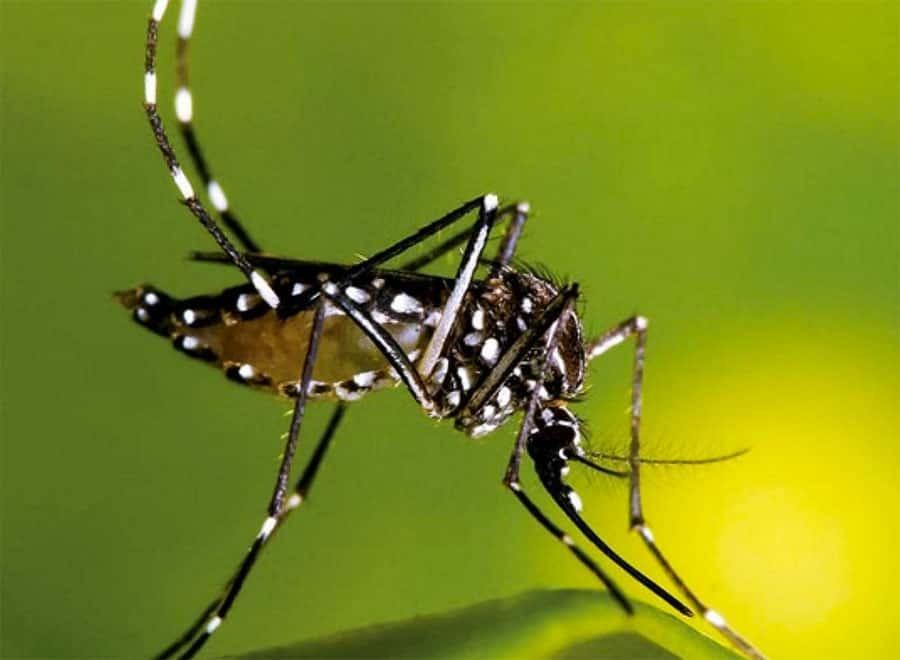
Unlike the use of pesticides, Debug?s sterile m ales can intuitively find wild Ae. aegypti populations, helping to target those that m ay be m issed by conventional m ethods. Ultim ately, Debug?s use of Wolbachia-infected m ale Ae. aegypti m osquitoes to reduce Ae. aegypti population presents prom ising results, and they can hopefully overcom e the barriers preventing scale

W hile reducing the m osquito population stands as a prom inent m ethod of slowing disease spread, it?s also im portant to address how m osquitoes find their targets in the first place: W hen exposed to CO2 exhaled by hum ans (and other m am m als), the m osquitoes track the gas and use visual, olfactory, and therm al cues to find their target (van Breugel et al.). A team of researchers from the University of Washington used CRISPR-Cas9 gene editing technology to m anipulate the visual genes of Ae aegypti (Zhan et al ) CRISPR-Cas9 is a technology that uses targeted RNA and enzym es to edit or delete portions of a subject?s DNA (CRISPR Therapeutics). By deleting two specific genes found in the eyes of Ae aegypti, the researchers were able to prevent the visual seeking of targets when exposed to CO2 (Zhan et al.). The elim ination of visual target apprehension would substantially reduce the m osquito?s ability to detect and bite targets, directly reducing m osquito-caused deaths and lowering Ae aegypti population. It should be noted that while visual sensing is rem oved, gene editing does not affect olfactory or therm al sensing, but these are m uch less useful at a longer range.

"Theelimination of visual target apprehension would substantially reducethemosquito?sability to detect and bitetargets, directly reducing mosquito-caused deaths"
M odern biotechnology shows prom ising results when it com es to reducing the prevalence of m osquito-borne illnesses. Specifically, these two studies propose possible solutions to the daunting problem of the Aedes aegypti m osquito, and with m ore research and developm ent, they can put a dent in the 725,000 yearly deaths caused by m osquito-borne illness.
Works Cited
CRISPR Therapeutics. ?CRISPR/Cas9.?CRISPR Therapeutics, CRISPR Therapeutics, No date, https://crisprtx.com /gene-editing/crispr-cas9. Accessed 24 October 2022
Debug ?How It Works?Project Debug, Verily Life Sciences LLC, No date, https://debug.com /how/. Accessed 24 October 2022.
Pfizer. ?M osquito as Deadly M enace.?Pfizer, Pfizer, Inc., 4 October 2016, https://www.pfizer.com /news/articles/m osquito as deadly m enace. Accessed 24 October 2022
van Breugel, Floris, et al. ?M osquitoes Use Vision to Associate Odor Plum es with Therm al Targets.?Current Biology, Elsevier, 17 August 2015, https://reader.elsevier.com /reader/sd/pii/S096098221500740X?token=
9D09372C7D5A412DD7FE8F6A7836EC90BD5BECE3417303AAEAFD30158
CCC6307B7A535A261AD494098285943E6A72E04& originRegion=us-east-1 & originCreation=20221024163310. Accessed 24 October 2022.
Weissm an, M ichael. ?M osquito of the M onth: Aedes aegypti? The Yellow Fever M osquito.?Vector Disease Control International, No date, https://www vdci net/blog/m osquito-of-the-m onth-aedes-aegypti-yellow-feverm osquito/. Accessed 24 October 2022.
Zhan, Yinpeng, et al. ?Elim ination of vision-guided target attraction in Aedes aegypti using CRISPR ?Current Biology, Elsevier Inc , 27 Septem ber 2021, https://www.cell.com /current-biology/fulltext/S0960-9822(21)00958-1. Accessed 24 October 2022
FRC T eam 2415: T h e W estm i n ster W i r edCats

A Featu r e on th e 20 23 Season .
Avi AgrawalThe Westm inster W iredCats is our school?s robotics team , and it m ay not be what you were expecting There are m any different robotics organizations and events across the country, including som e that you m ay know, like FLL and VEX, that focus on sm all, low tech robots. These com petitions often have constricting param eters and little room for creativity, however, the FIRST Robotics Com petition (FRC) throws m any of the predeterm ined conventions out the window. An organization based on principles of outreach and collaboration, FIRST re-thinks high school robotics by fostering creativity and technological innovation am ong students across the world through m assive robots of our own design. Like m any other robotics com petitions, FIRST holds annual 12 week seasons in which they introduce a brand new gam e for that year and hold com petitions over the last 6 weeks of the season. This year?s gam e, ?Charged Up!?had one of the m ost exciting seasons to date
The W iredCats have a yearly tradition called kickoff, where the entire team gathers together and watches the yearly gam e announcem ent stream There?s lots of food and fun, but the m om ent the year?s gam e is announced, all play is forgotten In bursts of energy and excitem ent, groups split up into discussion about various aspects of the gam e including rules, penalties, and potential design ideas. This year, the gam e was deceptively sim ple. The gam e consisted of two alliances, or team s, of three random ly chosen robots who com pete against each other. The goal of the gam e was to gather as m any cubes and cones, which are retrieved from the field or a designated zone, and score them on a scoring ?node?. The nodes were organized in different heights and distances from the robot and corresponded to different scores when a robot filled one of these positions Finally, during the last 30 seconds of the gam e, a period called the ?end gam e?, the robots have the ability to balance on the ?charging station?, a wobbly m etal platform to score m ore points for their alliance The alliance with the m ost points by the end of a round wins ranking points, the key decider in robot rankings


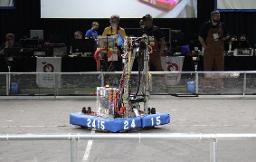

This year, our team played in 2 district com petitions in Lawrenceville and M acon as well as in the district cham pionship in Em erson Our very first com petition was in Lawrenceville, and we m anaged to win it all, assisting our alliance partners in the elim ination bracket of the tournam ent and com ing out on top in the finals! I had the am azing opportunity to drive throughout the qualifying and elim ination m atches and was able to m eet m any incredible people across both team s while discussing strategy or actively driving on the field. We were picked as the final robot to the #2 seeded alliance by Colum bus Space Program and North Gwinnett H igh School. Our next com petition was in M acon and it was held at M ercer University.



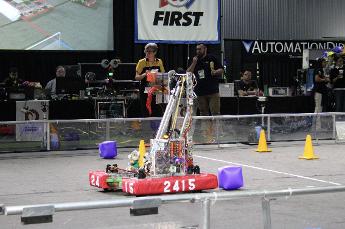
Though we were elim inated in the second round of playoff m atches, we were able to score enough points in order to have the opportunity of com peting in the district cham pionship! Our team was also recognized for outstanding creativity in the design of our robot for our custom ?swerve?drive and 3-D printed wheels After a week of downtim e, we were back on the road once m ore to com pete at our final com petition of the season. Through everything that we had learned over the past few weeks, our team was reborn during the cham pionship We overcam e m any challenges and began to perform better and better as the com petition progressed. We truly tried our best, however, we were unable to gain enough points to m ake it to the World Cham pionship in Houston. Even though our season ended earlier than m any of us wanted, I can say for a fact that I am proud of everything our team accom plished throughout the season, and look forward to m any m ore with the am azing team of the 2415 W iredCats.

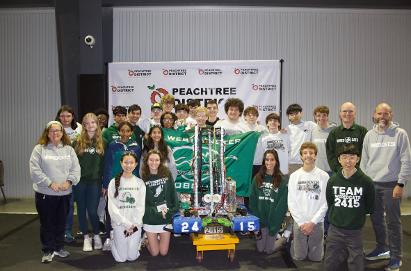
Br i n g Back an Ex ti n ct Rh i n o Su bsp eci es
CarolineChu






On August 6th, 2022, a new southern white rhino calf was born at the San Diego Zoo Safari Park?s Nikita Rhino Rescue Center. W hile this new m ale calf is of a different subspecies, he m arks the next step in bringing back the northern white rhino from near extinction. The last rem aining m ale northern white rhino died in M arch 2018, and the two rem aining fem ale northern white rhinos live in Kenya, but they are past reproductive age The m other of the new southern white rhino calf at the San Diego Zoo is Livia. She is a first tim e m om , and the successful birth of her calf proves that Livia is able to carry a calf to term and care for the calf This m akes Livia a vitally im portant rhino because she is one of three southern white rhinos at the zoo who could potentially be a surrogate m other for a northern white rhino em bryo.
Not only could Livia be the surrogate, she was also closely studied so that researchers could gain m ore knowledge about the southern white rhino?s reproductive cycle. They collected data on when the reproductive cycle begins as well as the phases. This inform ation will be applied in the future and will allow researchers to be prepared as they plan to im plant a northern white rhino em bryo into a southern white surrogate m other in the hope that the surrogate could give birth to a genetically pure northern white which will provide the foundation for repopulation
The stem cell biologists plan to use northern white rhino tissue from the San Diego Zoo W ildlife Alliance?s ?frozen zoo,?the largest cryobank in the world of anim al cells, to create a northern white em bryo. The cryobank contains skin cells from twelve different northern white rhinos which they believe is enough to create a healthy and genetically diverse rhino population. However, the challenge is that researchers are having to design the em bryo creation process from scratch They even have to design basic steps such as the correct petri dish culture, the nutritional layer of the petri dish that will allow a fertilized egg to grow.

San Diego Zoo W ildlife Alliance researcher Carly Young said that the biologists used protocols developed from the horse, dom estic cat, deer, and even hum ans to create the m aturation m edia for the northern white rhino.







Before anything else, however, scientists have to be certain that their procedure will work correctly in southern white rhinos before they begin using any of their lim ited supply of northern white cells W hile Germ an scientists have already created northern white em bryos using eggs from the two rem aining northern white rhinos, they were unable to successfully transfer em bryos. However, the San Diego Zoo is m aking progress. Two of their rhinos have already gotten pregnant from artificial insem ination which was a first for zoos in North Am erica The insem inations using frozen sperm allowed researchers to learn even m ore about the rhino?s reproductive cycle because the rhinos were trained to have ultrasounds and other health checks, giving researchers the chance to take crucially im portant m easurem ents of the fetus
The northern white rhino skin cell sam ples are stored in nitrogen cooled freezers where stem cell biologists attem pt to get northern white rhino stem cells from these skin sam ples. Stem cells are the m ost basic form of cells and are what all other cells develop from .


However, researchers only have skin cells not stem cells, and this created a m ajor issue. Skin cells, like all other types of adult cells, cannot turn into other kinds of cells once developed However, the inform ation to develop into different types of cells is still in the genetics of the skin cells, so theoretically the researchers could use that to create stem cells.






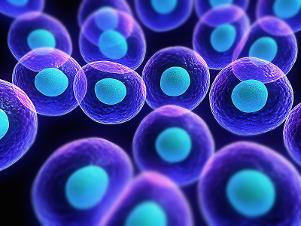
To access those genes, researchers m ust first perform steps to reset and rem ove all of the cell?s program m ing to return it to a stem cell This process has been perform ed on the cells of other anim als and also hum ans, but never before on rhinos. There are four regulatory m olecules that are known as Yam anaka factors which are needed to reset a skin cell These factors control the way that DNA is copied for translation into other proteins. In 2021, the San Diego Zoo?s researchers were able to create one northern white stem cell from 100,000 skin cells. Since then they have m ade adjustm ents to increase efficiency that allow them to create seven stem cells from 100,000 skin cells, and while this process still has to be optim ized, the fact that they have been able to m ake even one northern white stem cell is im pressive. Since adult stem cells can becom e any cell in the rhino?s body, stem cells allow for the creation of em bryos. W hile researchers have been able to accom plish the creation of em bryos from stem cells in m ice, it has never been done before in rhinos The researchers collected skin cells from the last m ale northern white that was kept at the San Diego Zoo, and using these cells, the biologists were able to develop them into rhino heart cells. The cells, called cardiom yocytes, even expand and contract on the Petri dish naturally. These heart cells are a m ajor source of hope for the im plantation of northern white em bryos into the southern white surrogates

The second step to creating an em bryo is developing the stem cells into prim ordial, the earliest stage of cell developm ent, sperm and eggs The process of turning stem cells into sperm and egg cells is incredibly difficult. It requires sending intracellular signals at the perfect concentration, tim ing, and duration to m ake the stem cells turn into the desired type of cell The intracellular signals could be growth factors or certain chem icals that turn on or off pathways during the cell cycle. The researchers can then use the signals to direct the cell to turn into specific genes Once created, however, keeping stem cells healthy and alive is difficult. If the cells aren? t fed frequently, the growth factor m akes the stem cells m aintain their stem cell state, and then they will break down. The stem cells are also highly sensitive to heat which requires constant m onitoring of the tem perature which m ust rem ain at -321degrees Fahrenheit or else the cells will die. The stem cell biologists have developed the tedious care instructions necessary and have already yielded spectacular results.








Step three is fertilizing the egg with the sperm , both created from stem cells, to create an em bryo. The first requirem ent for fertilizing an egg is to have an alive and m ature egg and sperm However, scientists m ust now create the perfect environm ent for the egg to grow because the egg wouldn? t be inside of the ovaries The scientists have to learn to recreate the ovarian environm ent?s ?Goldilocks Zone?which is a perfect tem perature, horm one and nutrient concentrations, and ratio of gasses such as carbon dioxide and oxygen that allows the eggs to grow. To find this rare Goldilocks Zone, the scientists first experim ented with southern white rhino eggs The team at the zoo had previously only had access to eggs harvested after a southern white had passed away, and these eggs were not as healthy as those from living rhinos. In M arch 2020, the team m ade great progress and was able to successfully harvest 22 live eggs They achieved a 50%m aturation rate and produced an em bryo in an im pressive first attem pt.

The fourth step, the im plantation of the northern white em bryo, is where southern white rhinos like Livia com e into play. The fetus will grow and develop in the wom b of the southern white. This step, although it m ay sound sim ple, also presents m ajor challenges. The wom b has a dynam ic nature, and in order to support a growing fetus, the em bryo and the wom b have to be in sync with one another.

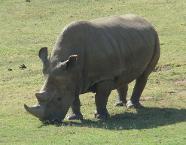








The researchers used ultrasounds to learn how to synchronize the wom b and the fetus The rhinos were trained to willingly participate in the ultrasounds The zookeepers have perform ed over 1,000 ultrasounds and have gained significant am ounts of data about the reproductive system .
The data was used to learn when in their cycle rhinos are m ost likely to accept an em bryo transfer Researchers have also developed a series of horm one treatm ents which increase a rhino?s likelihood of accepting an em bryo by inducing ovulation within 48 hours. As a sign of the researcher?s new discoveries, in 2019 two southern whites were artificially insem inated and gave birth to healthy calves. Livia has now joined them as possible surrogates for the northern white rhino em bryo.







The technology being developed for the northern white rhinos could even be applied for other endangered anim al species Oliver Ryder, the San Diego Zoo?s director of conservation genetics, places an im portance on the creation of ?a global network of frozen zoos?such as the one in San Diego because having skin cells of every species is like an insurance policy Should anything happen to the population of a species, there is the potential to bring the species back from frozen skin sam ples. This new em bryo im plantation research holds the secret to reviving a lost species as well as preventing others from going extinct
Bibliography
Dance, Am ber "San Diego's Frozen Zoo Offers Hope for Endangered Species around the World " Knowable M agazine Sm ithsonian M agazine, www.sm ithsonianm ag.com /science-nature/san-diegos-frozen-zoo-180971276/. Accessed 27 Oct. 2022
Rogers, Peter. "Northern W hite Rhino: Resurrecting an Extinct Species in Four Steps." Big Think, 22 M ar 2022, bigthink com /life/resurrection-deextinction-northern-white-rhino/ Accessed 28 Oct 2022
Schm iedeberg, Renee "A New Hope: Southern W hite Rhino Calf Born at San Diego Zoo Safari Park " NBC 7 San Diego, NBC Universal M edia, 23 Aug 2022, www.nbcsandiego.com /news/local/a-new-hope-southern-white-rhino-calfborn-at-san-diego-zoo-safari-park/3029120/. Accessed 25 Oct. 2022.

Three sum m ers ago, I was sitting with m y sister in our backyard, m indlessly watching Youtube? when we both saw a video of a com m ercially sold ?Sisyphus Table? It was m esm erizing: a circular coffee table with a bed of sand underneath a glass top. A m etal m arble would then effortlessly glide through the sand, being pulled by a m otorized m agnet underneath the table, leaving an intricate geom etric trail behind We were both captivated and just needed to get one, so we went to their website. The $2000 price tag im m ediately ended our hopes of ever getting one. But I thought: If I can? t buy one? why not build one?
Just one sm all problem ? I knew alm ost nothing about engineering, woodworking or really any skill needed to tackle such a project However, I blindly progressed forwards. I first needed wood for the table?s base, but plywood was too expensive so I went dum pster diving down m y street until I found a usable piece of wood I then watched Youtube tutorials on how to cut the wood into a circle using a table saw, and eventually how to program an Arduino to control Nem a-17 stepper m otors. Over the next few years, I went through m ultiple design iterations and eventually settled where the project is now? so let m e give you a quick rundown of how it works.

The inner m echanism uses two stepper m otors. One slides the m agnet back and forth on an axis using a ball screw linear actuator, and the other m otor rotates the entire axis around the center of the table. By using this approach, the m agnet can reach any point within the circle. The m echanism relies on polar coordinates, where instead of using X and Y coordinates like you would in a 3-D printer or CNC, you specify an angle and a distance from the origin, where each m otor corresponds to either value. The m otors them selves are Nem a-17 stepper m otors, which rotate in very sm all increm ents and are controlled by TM C2209 stepper m otor drivers. The stepper m otor drivers are then controlled by the ?brains?of the table, the ESP32. The ESP32 is a super inexpensive m icrocontroller akin to an Arduino, except it runs with Bluetooth Low Energy and W i-Fi built in! Using this wireless connectivity, I was able to create a m obile app using Flutter, Google?s m ulti platform app developm ent fram ework.




The app uses Bluetooth to connect the table to W i-Fi along with short actions such as pausing or playing the current design. W i-Fi is used to upload and download different track designs to and from the table with an H TTP web server. But enough with the boring technical jargon, let's talk about actually building the table.


I?ve gotten m any parts off of Am azon, and learned how to use them through online resources But som e parts of the table I had to build m yself. This is where the Innovation Lab cam e in to help m e W hen I started working on this project, I was not yet a student at Westm inster and had little to no access to proper tools and equipm ent. However, since I started m y current year, I?ve been able to utilize m any different parts of the lab. I laser cut a 345-tooth wooden gear to use for rotating the central axis I also had to 3D-print a couple parts to support the ball screw axis, house the m agnet, or m ount the rotational m otor.


One m ain goal I had in m ind while designing this project was ease of use I could have probably finished the table m any m onths earlier if I had gone with a sim pler approach by elim inating wireless features, scrapping the m obile app, and just reading files directly off of a m anually-loaded SD card. But I wanted to create som ething as close to perfect as I could so that I could be proud of it. It has been very difficult, but I?ve designed it so that even m y grandm other could use it.
Looking back three years ago at m y sister and I m arveling at the joys of art and engineering, it?s m otivating to see how far I?ve com e M y favorite part of this project has been being able to see things slowly com e together? but I?m not quite finished just yet. I still have to actually build the whole exterior of the table as I?ve only really finished the inner m echanism , program m ing, connectivity, and the m obile app. However, I have really enjoyed working on the project so far and it has given m e a m uch greater understanding and appreciation for STEM . I?m looking forward to continuing working on the table, and can? t wait to see what it will eventually becom e.


FDM ax is m y custom -built 3D printer. Since Septem ber, I?ve been working to fabricate m y personalized design with m y own hands, and the experience has been as rewarding as it?s been fun Constructing FDM ax gave m e a chance to create a m achine with features com m only overlooked on the m arket, and m ore im portantly, the project taught m e invaluable lessons that proved vital to m ake it all possible
Over the two years that I owned a 3D printer, I learned plenty about how 3D printers work. I got m y first 3D printer for m y 13th birthday, and I had alm ost no idea how to operate and m aintain it by m yself. Nonetheless, I quickly learned the skills and m echanics of 3D printing, and m y 3D printer becam e one of the m ost fun and interesting things I owned. But by the tim e I turned 15, I wanted som ething better. M y Anycubic M ega S 3D printer was great, but I wanted a m achine that I could m odify, upgrade, and connect to other things, som ething that the proprietary design didn? t seem to provide. Conveniently enough, that was when I started m y tim e at Westm inster, which offered m e the resources I needed to pursue this idea

Advantages
FDM ax is m eant to im prove on all of the areas in which I noticed m y Anycubic M ega S was lacking, taking inspiration from existing products. It isn? t just Fused Deposition M odeling ? it?s Fused Deposition M ax-im ized! FDM ax offers these awesom e features to nam e a few, things that you won? t find in lots of the 3D printers on the m arket:
- Vertical bed: M any 3D printers on the m arket have beds that m ove back and forth to serve as the y-axis, but that m eans that their footprint depth is alm ost twice their bed length! FDM ax has a bed that only m oves up and down, so y-m otion m akes no contribution to the footprint.
- CoreXY design: M ost Cartesian 3D printers are built with one axis that m ust carry the m otor for another. This results in m ore work having to be done by the printer as it m oves, and therefore less speed and m ore wear W ith CoreXY, an innovative belt design allows all m otors to rem ain stationary, so the m oving parts are as lightweight as possible. (To understand the CoreXY theory, see this website that has helped m e: https://corexy com /)
- Interchangeable toolhead: 3D printers typically have a hotend, which is what m elts the filam ent and lets it flow onto the m odel However, the m otion and precision that a 3D printer offers shouldn? t be restrained to just 3D m odels; I intend for FDM ax to have plug-and-play tools in later stages, including laser engravers and even pencils, to fully take advantage of its capabilities
- Enclosure: Less-expensive 3D printers are often open-air printers, having no walls around them . H aving no walls is fine for printing in PLA (a type of plastic filam ent), but it quickly poses issues with other m aterials. W ith TPU, as I?ve observed firsthand, an open-air 3D printer releases awful fum es And with ABS, which is very sensitive to tem perature differences, the air around the m odel is too cold, causing the m odel to curl. H aving an enclosure serves to insulate the m odel and contain terrible fum es
- Integrated Raspberry Pi: W ith a Raspberry Pi, m y 3D printer would have nearly lim itless capabilities. Prim arily, it would be W iFi enabled via OctoPi, a beautiful and incredibly useful platform through which I can rem otely m onitor m y 3D printer and operate it without the need for SD cards or a connected PC Additionally, FDM ax will have a webcam , 7-inch LCD screen, and m ulticolor LED lights. Yes, FDM ax will have style!
Process
I began m ajor construction of m y new 3D printer in Septem ber (shown to the right) Originally, I intended for there to be a m eter of build length to m ake a truly m axim ized build volum e W ith the desire to im prove as m uch as possible from m y old 3D printer, I continued work on this through the winter. Som ething was terribly wrong, though.
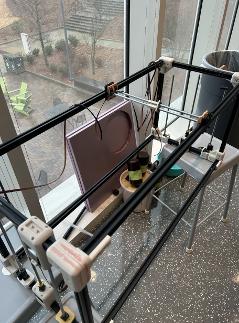
By February, I realized that I needed to change m y approach to construction. This wasn? t new; finding what m aterials and m ethods worked best for m easuring, com bining, constructing, and realizing ideas took years of trial and error The big lesson I learned in February was that for large projects, a com prehensive design is vital for success W hen I started construction, I knew a solid design would be necessary, but I realized in February that even a bulletproof-sounding plan can topple if it?s incom plete M y lack of foresight had caught up with m e, and com pletion becam e im possible, specifically with the belt system . That?s when I began to design m ore thoroughly in an Onshape assem bly, and I did it right All of the design fit together and included the things I wanted to include, and I just needed to build it, no questions asked I finished m y design in M arch
After disassem bling the partly-built 3D printer, I im m ediately began work on the fresh new concept. Unfortunately, m y process was heavily delayed because the 3D printers in the lab weren? t operational, so I couldn? t m ake m y parts Yes, it takes a 3D printer to m ake a 3D printer
I started by creating the bed assem bly In the picture to the left, I have the com pleted bed assem bly with the Onshape design in the background The bed assem bly had two Z-steppers and carried the bed, which slid along four rails and two screws.
After the bed assem bly, I built the fram e. The fram e m ade it start to look like a real 3D printer! After securing all of the 2020 extrusions (m etal bars) together, I put the bed assem bly into place The m ost satisfying part of m aking things is when two separate pieces fit together perfectly. The fram e and bed are shown to the right.
W ith a bit m ore work, I added three m ore stepper m otors to control the XY m otion and the extrusion. After a slight design m odification (because I didn? t want to pay $15 for longer screws), I fabricated the XY gantry, the part that carries the nozzle To com plete the m otion m echanism s, I added the CoreXY belts All of the m echanism s m oved properly
I started by creating the bed assem bly In the picture to the left, I have the com pleted bed assem bly with the Onshape design in the background The bed assem bly had two Z-steppers and carried the bed, which slid along four rails and two screws.
After the bed assem bly, I built the fram e The fram e m ade it start to look like a real 3D printer! After securing all of the 2020 extrusions (m etal bars) together, I put the bed assem bly into place The m ost satisfying part of m aking things is when two separate pieces fit together perfectly. The fram e and bed are shown to the left W ith a bit m ore work, I added three m ore stepper m otors to control the XY m otion and the extrusion. After a slight design m odification (because I didn? t want to pay $15 for longer screws), I fabricated the XY gantry, the part that carries the nozzle To com plete the m otion m echanism s, I added the CoreXY belts All of the m echanism s m oved properly.



FDM ax has reached a m ilestone recently since its m otion features have m ostly been com pleted, and because of m y im proved process, it happened in a fraction of the tim e it took for the first m odel. The next step is the electronics panel, which will house the power regulator and m ainboard. That will be followed by flashing the firm ware to the board, and after som e m ore testing, I presum e, FDM ax will be fully operational. M y goal is to have the m ajority of the work done by the end of M ay.
Overall, this 3D printer project has been successful. The project offered a great opportunity to practice innovation in a com plex m achine, and personally, it taught m e a valuable lesson about the role of design in the m aking process. 3D printing has been a fun hobby and inspiration for m e, and I?m glad that I?ve been able to m ake a thoughtful contribution The project still continues, and if all goes right, it will be an incredible vision com e to life.


I N N O VAT I O N at W estm i n ster
Ex p lor i n g H i n ges i n 3D Pr i n ti n g
Audrey DeShetler ('24)
























"I m ade a m anta ray fidget toy that could flap its wings. I decided to m ake it with different hinges that I experim ented with over the year I went through a bunch of different hinges, and it was a trial and error process until I got to one that actually worked I decided the best strategy to approach this was 3D printing, so I designed anything that cam e to m y head and hoped it worked M ost of them didn't, and only one did, but it ended up working."

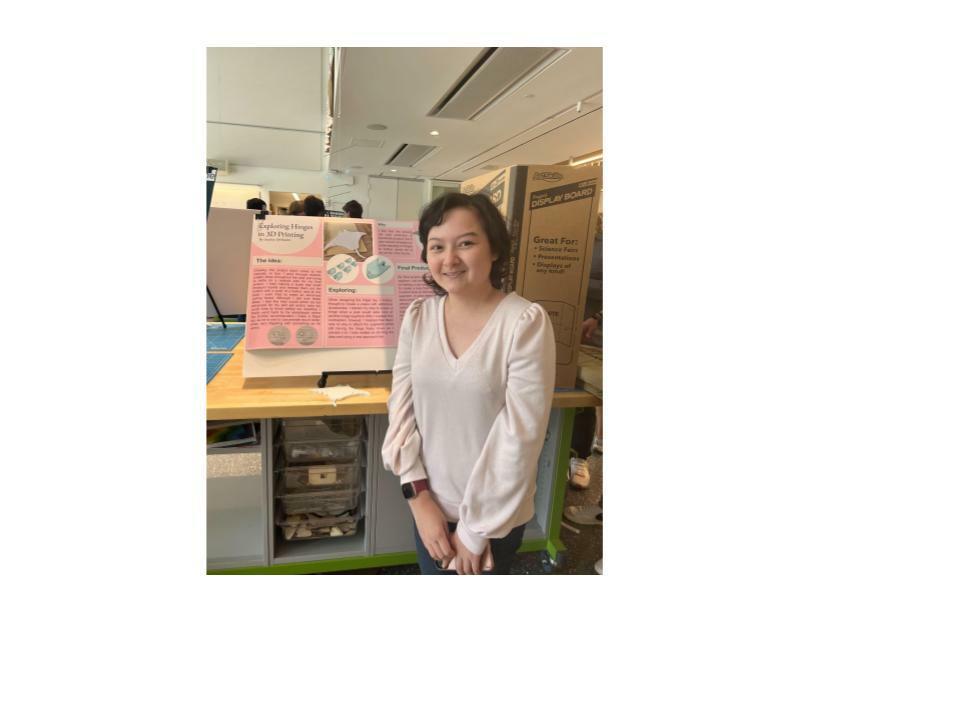
T h e Balan ce of L i f e
SabrinaFarley-Allen ('23)
"M y project is inspired by the work of Alexander Calder, and his m obiles that were m odern, adult works of art. I was really fascinated by them , and I created m y own to m odel one of the coolest "balancing" aspects of biology which is photosynthesis. I used a laser cutter to cut out all of m y pieces and I used Illustrator to deisgn them . I used copper rods and fishing line to put it all together. In the end, this will live in the lab to show what tools, open space, and m aterials we have to offer"
T abletop Gam e Boar d W
























 illiam Ivansco
illiam Ivansco
('24)
"M y project was building som e terrain boards for tabletop gam ing. The design process was kind of last m inute, as I had another project that didn't work out, so I took som e SPX foam boards and coated them with paint and applied grass flocking to them , which looks like fake grass. I see this being im plem ented at m y house, and I'll probably use it to play gam es with m y friends. I m ight give it to M r. Labouchere (Innovation Lab faculty m em ber) or anyone in the lab who wants it."
3D M od el of a Cell M em br an e Cam pbell Deitz ('23)
"I built a 3D m odel of a cell m em brane, which is com posed of a phospholipid bilayer and a few proteins I CADed everything in Onshape, which was really hard because m aking organic shapes in a program used for inorganic shapes is kind of difficult. For the phospholipids I used Onshape, and I CADed the proteins in Tinkercad I 3D printed everything, hand-painted it, and then I built the m odel "
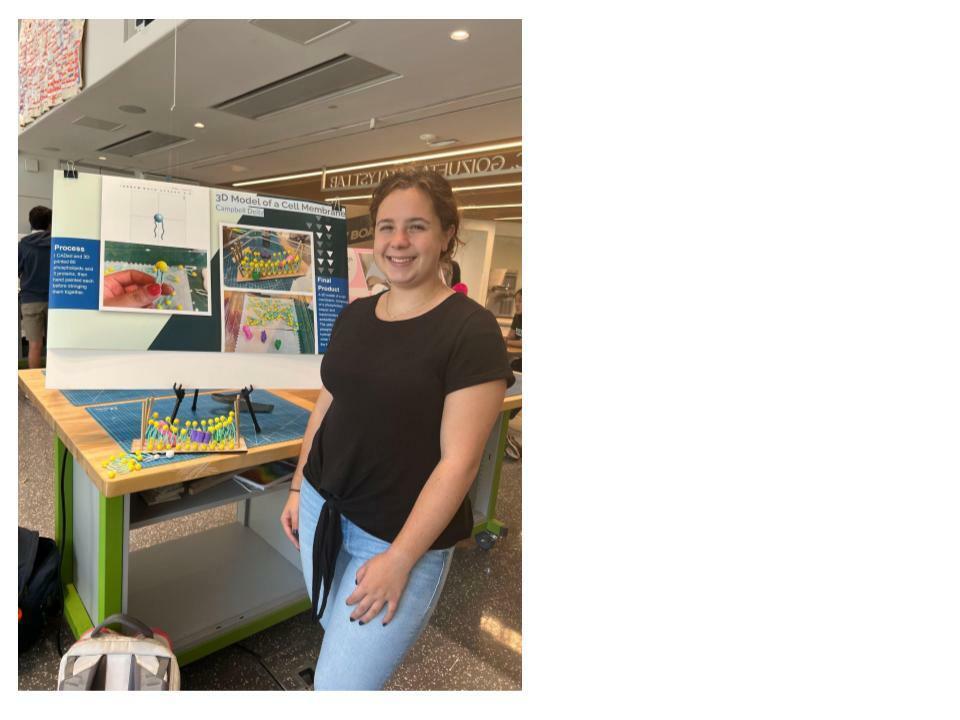

L ED L i gh t Raci n g Str i p s
Gideon Zem edhun ('24)"I did a track pacing system ; it's a scale m odel right now, and its an LED strip and each LED turns on and off The LEDs basically go across the strip, m atching whatever m ile pace you go into it. Its been used to break world records on the professional level, and is known as wavelight pacing. To do wavelight pacing on the track is quite a bit of wiring, coding, m oney, and power, so I created a scale m odel that uses individually addressable LEDs that can turn on and off independently."

























H atch i n g i n th e L ab
Peter Davis ('24)
"I 3D-printed birdhouses to be put on the Westm inster trails. I had to learn how to 3D design on m y com puter, and that was hte biggest struggle throughout the entire project. I got to learn about the 3D printers and how to use them . The purpose is m ainly about nature, and having people on the trails be able to see the nature in Westm inster. It's also to spread awareness of the Innovation Lab , as people who walk on the trails will see these things that are printed at the Catalyst Lab. "
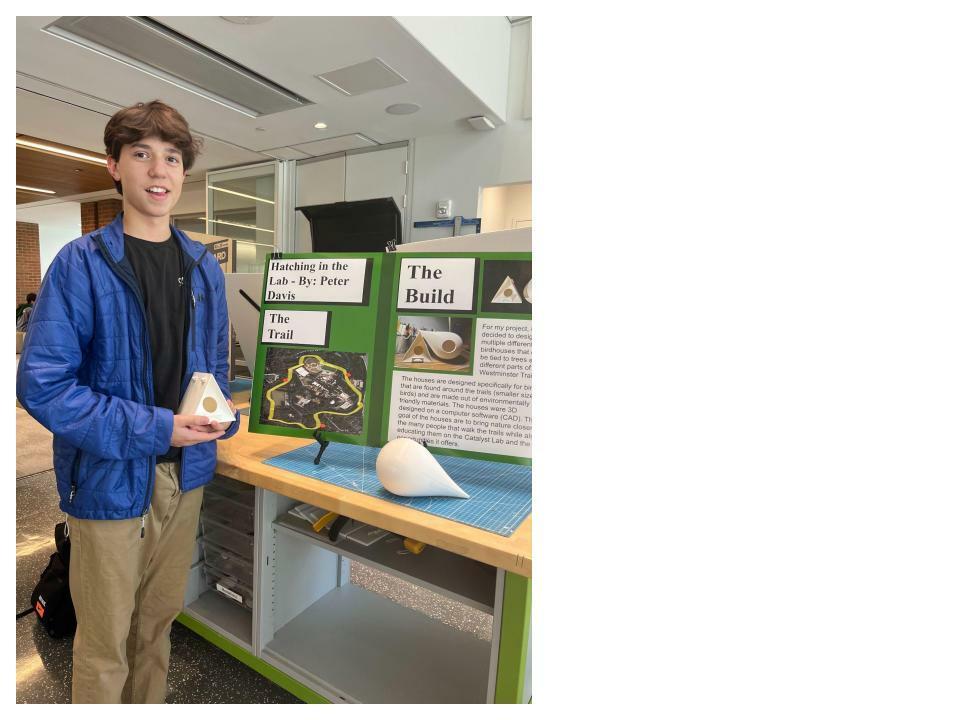
Su stai n able Bi k e Stan d Callum Capoor ('25)
"I designed and welded a bike rack featuring the Westm inster logo to help encourage eco-friendly transport on the Westm inster cam pus I started with one-inch m etal tubing, and I used a tube bender as well as som e angle grinders to help shape them into pieces I welded the pieces together, and for the W logos on the side, I used the CNC router in the RoboDen I'm really proud of the project; there was one stage where I was very disappointed, but I decided to power through and I'm really happy with the final result."
Car bon Em i ssi on s M od el Esfan Daya ('24)

























"I m ade a carbon em issions m odel, kind of like a topography m ap, but for carbon em issions around the world by country I m ainly used the laser cutter, as I laser cut each layer, which took a while, as well as general m aterials like wood glue. There was a few steps to m aking this, beginning with com ing up with the idea, designing each layer on Adobe Illustrator, cutting out the pieces and gluing them together, and going over it for final touches"


D o you h op e to w r i te abou t n ew f r on ti er s?
M ay be d i scover th em ?
D o you ap p r eci ate th e ch aos an d beau ty of sci en ce?

O r ar e you look i n g to lear n m or e?
W r i te f or Ver i tas! W e accep t ar ti cles r elati n g to an y
ST EA M -r elated top i cs. L ook ou t
f or si gn -u p sh eets on W i ld cat
Up d ates an d ar ou n d sch ool, or sen d u s an em ai l!










